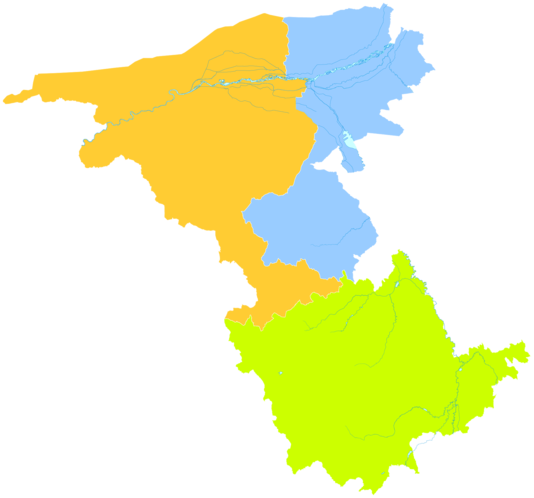Zhongwei
Zhongwei (simplified Chinese: 中卫; traditional Chinese: 中衛; pinyin: Zhōngwèi; Wade–Giles: Chung-wei; lit.: 'middle guard') is a prefecture-level city of Ningxia, People's Republic of China.
Zhongwei 中卫市 · ﺟْﻮوِ شِ | |
|---|---|
Wolfberry fields in Zhongning County, Zhongwei City | |
.png) Zhongwei in Ningxia | |
 Zhongwei Location of the city centre in Ningxia | |
| Coordinates (Zhongwei municipal government): 37°30′01″N 105°11′48″E | |
| Country | People's Republic of China |
| Autonomous region | Ningxia |
| Municipal seat | Shapotou |
| Area | |
| • Total | 16,986.1 km2 (6,558.4 sq mi) |
| Population | |
| • Total | 1,041,821 |
| • Density | 61/km2 (160/sq mi) |
| Time zone | UTC+8 (China Standard) |
| Postal code | 755000 |
| Area code(s) | 0955 |
| ISO 3166 code | CN-NX-05 |
| Website | nxzw |
It has an area of 16,986.1 km2 (6,558.4 sq mi) and a population of 1,041,821.[1]
Tourism
Zhongwei's main attraction is Gao Miao, a temple that has hosted Confucian, Buddhist, and Taoist ceremonies. A bomb shelter was also built beneath the temple during the Cultural Revolution. It has since been converted into a rendition of a Buddhist hell.[2] The prefecture is also the location of the beginning of the northern bend in the Yellow River that produces the Ordos Loop.
The world's largest photovoltaic power station, Tengger Desert Solar Park, is located in Zhongwei.[3]
Administrative divisions
| Map | |||||||
|---|---|---|---|---|---|---|---|
| Name | Hanzi | Hanyu Pinyin | Xiao'erjing | Population (2003 est.) |
Area (km²) | Density (/km²) | |
| Shapotou District | 沙坡头区 | Shāpōtóu Qū | ﺷَﺎپُتِﻮْ ﺛُﻮْ | 350,000 | 4,633 | 76 | |
| Zhongning County | 中宁县 | Zhōngníng Xiàn | ﺟْﻮنٍ ﺷِﯿًﺎ | 410,000 | 2,841 | 144 | |
| Haiyuan County | 海原县 | Hǎiyuán Xiàn | هَیْیُوًا ﺷِﯿًﺎ | 380,000 | 6,979 | 54 | |
Geography
| Climate data for Zhongwei (1981–2010 normals) | |||||||||||||
|---|---|---|---|---|---|---|---|---|---|---|---|---|---|
| Month | Jan | Feb | Mar | Apr | May | Jun | Jul | Aug | Sep | Oct | Nov | Dec | Year |
| Average high °C (°F) | 1.1 (34.0) |
5.7 (42.3) |
12.3 (54.1) |
19.8 (67.6) |
24.3 (75.7) |
27.7 (81.9) |
29.4 (84.9) |
27.7 (81.9) |
23.6 (74.5) |
17.6 (63.7) |
9.3 (48.7) |
2.5 (36.5) |
16.8 (62.2) |
| Daily mean °C (°F) | −7.2 (19.0) |
−2.6 (27.3) |
4.2 (39.6) |
11.8 (53.2) |
17.1 (62.8) |
20.9 (69.6) |
22.9 (73.2) |
21.0 (69.8) |
16.0 (60.8) |
9.5 (49.1) |
1.8 (35.2) |
−4.9 (23.2) |
9.2 (48.6) |
| Average low °C (°F) | −13.5 (7.7) |
−9.0 (15.8) |
−2.3 (27.9) |
4.3 (39.7) |
9.9 (49.8) |
14.1 (57.4) |
16.6 (61.9) |
15.1 (59.2) |
10.0 (50.0) |
3.3 (37.9) |
−3.5 (25.7) |
−10.4 (13.3) |
2.9 (37.2) |
| Average precipitation mm (inches) | 1.5 (0.06) |
1.4 (0.06) |
3.4 (0.13) |
10.8 (0.43) |
18.1 (0.71) |
26.8 (1.06) |
33.6 (1.32) |
44.0 (1.73) |
22.8 (0.90) |
12.0 (0.47) |
1.6 (0.06) |
0.5 (0.02) |
176.5 (6.95) |
| Average relative humidity (%) | 52 | 47 | 45 | 41 | 49 | 57 | 63 | 68 | 68 | 60 | 59 | 56 | 55 |
| Source: China Meteorological Administration[4] | |||||||||||||
Transportation
.jpg)
- Zhongwei Shapotou Airport
- Baotou–Lanzhou Railway
- Baoji–Zhongwei Railway, to points south (connections to Xi'an, Chengdu)
- Taiyuan-Zhongwei-Yinchuan Railway, to points east (connection to Beijing)
- Gantang–Wuwei Railway, to western Gansu and points west
- Zhongwei–Lanzhou high-speed railway
Photo gallery
 Desert Lake
Desert Lake Desert Lake
Desert Lake Desert Lake
Desert Lake.jpg) Shapotou scenic area
Shapotou scenic area.jpg) Camels in Shapotou
Camels in Shapotou Zhongwei cultural centre
Zhongwei cultural centre
References
- (in Chinese) Profile of Zhongwei, visited on May 31, 2008.
- Harper, Damian; Fallon, Steve; Gaskell, Katja; Grundvig, Julie; Heller, Carolyn; Huhta, Thomas; Mayhew, Bradley (2005). China (9th ed.). Lonely Planet. p. 980. ISBN 978-1-74059-687-9. OCLC 61143558.
- "10 really cool Solar Power installations in (and above) the world". 29 January 2018. Retrieved 10 May 2018.
- 中国气象数据网 - WeatherBk Data (in Chinese). China Meteorological Administration. Retrieved 2020-04-16.

